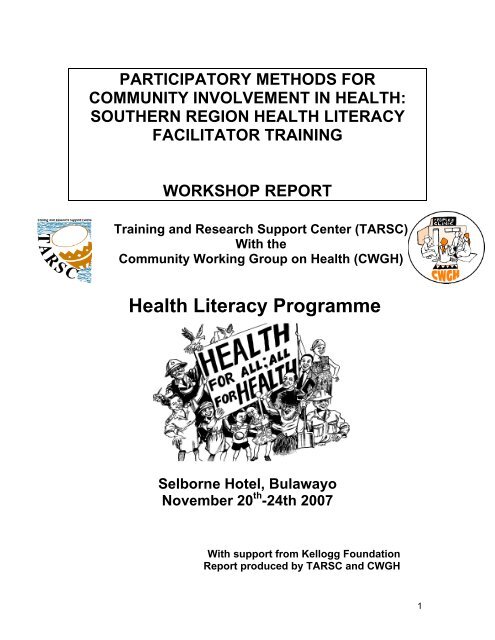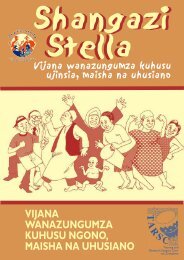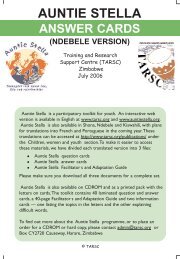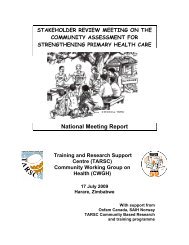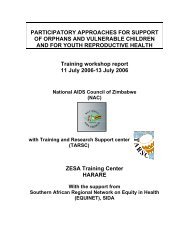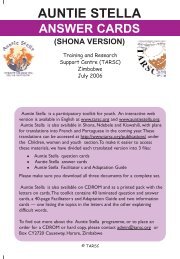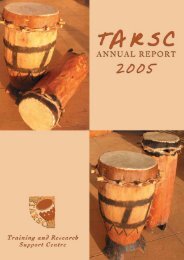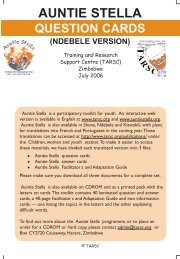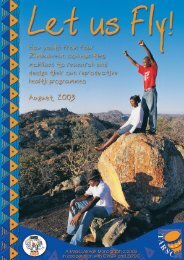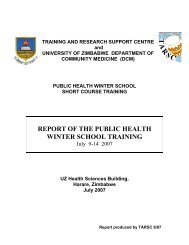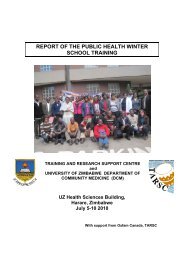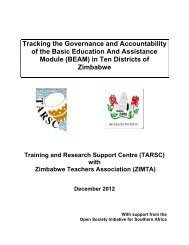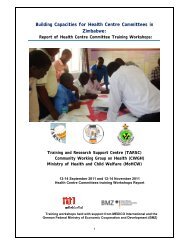HL sthnreg factng rep07.pdf - Training and Research Support Centre
HL sthnreg factng rep07.pdf - Training and Research Support Centre
HL sthnreg factng rep07.pdf - Training and Research Support Centre
Create successful ePaper yourself
Turn your PDF publications into a flip-book with our unique Google optimized e-Paper software.
PARTICIPATORY METHODS FOR<br />
COMMUNITY INVOLVEMENT IN HEALTH:<br />
SOUTHERN REGION HEALTH LITERACY<br />
FACILITATOR TRAINING<br />
WORKSHOP REPORT<br />
<strong>Training</strong> <strong>and</strong> <strong>Research</strong> <strong>Support</strong> Center (TARSC)<br />
With the<br />
Community Working Group on Health (CWGH)<br />
Health Literacy Programme<br />
Selborne Hotel, Bulawayo<br />
November 20 th -24th 2007<br />
With support from Kellogg Foundation<br />
Report produced by TARSC <strong>and</strong> CWGH<br />
1
Table of contents<br />
1. Background.......................................................................................................3<br />
2. Overview of the health literacy programme.......................................................5<br />
3. The Community Working Group on Health .......................................................5<br />
4. How TARSC works on health............................................................................8<br />
5. Introduction to health literacy <strong>and</strong> PRA.............................................................8<br />
6. Health of communities ....................................................................................10<br />
7. Healthy Environments.....................................................................................12<br />
8. Healthy Nutrition .............................................................................................13<br />
9. Underst<strong>and</strong>ing health systems........................................................................14<br />
10. Community roles in health systems ..............................................................16<br />
11. Next steps <strong>and</strong> closing..................................................................................17<br />
Appendix 1: The programme ..............................................................................21<br />
Appendix 2: The delegates list............................................................................24<br />
2
1. Background<br />
In November 2007, <strong>Training</strong> <strong>and</strong> <strong>Research</strong> <strong>Support</strong> <strong>Centre</strong> (TARSC) <strong>and</strong><br />
Community Working Group on Health (CWGH) under the Regional Health Literacy<br />
programme held a five-day Health literacy facilitator-training workshop. It aimed at<br />
introducing the health literacy programme <strong>and</strong> provide core skills <strong>and</strong> information to<br />
CWGH health literacy facilitators to implement the programme.<br />
The regional health literacy programme in east <strong>and</strong> southern Africa is being<br />
implemented through TARSC Zimbabwe in co-operation with CWGH Zimbabwe, with<br />
MHEN Malawi <strong>and</strong> the Regional network for Equity in health in east <strong>and</strong> southern Africa<br />
(EQUINET). The programme aims to support the development <strong>and</strong> use of participatory<br />
health education materials for health civil society. It is being implemented in Zimbabwe,<br />
Malawi <strong>and</strong> in third country being identified in 2008 with support from Kellogg<br />
Foundation.<br />
This report presents a summary of the proceedings of the 5-day workshop. It<br />
involved facilitators drawn from the academia, private industry, associations, health<br />
institutes, health workers, <strong>and</strong> various governments’ institutions of Zimbabwe under<br />
the CWGH umbrella as listed in Appendix 2.<br />
TARSC <strong>and</strong> CWGH have a history of work on<br />
Participatory Reflection <strong>and</strong> Action (PRA)<br />
approaches in health since 1997 through the<br />
Civic Education Programme on Health. This<br />
programme in the CWGH arose because of<br />
well-articulated dem<strong>and</strong>s for information <strong>and</strong><br />
participation arising from a survey of health<br />
needs <strong>and</strong> the priority strategies in 1998. The<br />
programme <strong>and</strong> materials for it were<br />
developed by TARSC/CWGH members <strong>and</strong><br />
covered public health, health systems <strong>and</strong><br />
organizational issues prioritized by the<br />
CWGH. The programme used participatory<br />
approaches, facilitators were trained from<br />
within CWGH members <strong>and</strong> a facilitator’<br />
guide was provided with the training materials<br />
to support these roles. The CWGH used the<br />
programme between 2000 <strong>and</strong> 2006 to<br />
support district activities, dialogue with health<br />
care providers <strong>and</strong> to strengthen informed<br />
participation <strong>and</strong> joint planning on health<br />
activities. An evaluation of the programme<br />
was carried in 2005 by TARSC with CWGH,<br />
separately reported ([see: TARSC (2005)<br />
Evaluation of the CWGH Civic education<br />
programme on Health TARSC: with CWGH,<br />
Harare Zimbabwe] Discussion of this<br />
evaluation revealed information, capacity <strong>and</strong> skills gaps that would be addressed in the<br />
next stage of health literacy training <strong>and</strong> in the development of a Health Literacy manual<br />
3
[see: TARSC, CWGH (2006) The CWGH facilitators’ review meeting report; 1-2<br />
November; Silveira house- Harare TARSC: Zimbabwe]<br />
The Health Literacy manual was developed by TARSC with input from CWGH, piloted,<br />
peer reviewed, revised, edited <strong>and</strong> finalized (Loewenson R, Kaim B, Machingura F<br />
(TARSC) Rusike I, Chigariro T, Mashingaidze L, Makone A (CWGH) (2007) Health<br />
Literacy guide for people centred health systems: Zimbabwe, TARSC: Zimbabwe)<br />
The criterion for selection of a Health Literacy Facilitator (<strong>HL</strong>F) was determined at the<br />
CWGH board meeting, with characteristics including that the person would:<br />
• Be a member of a CWGH member institution with a district level function- e.g.<br />
committee member, educator, organizer, youth member etc<br />
• Have had experience of working with CWGH for 2 years or more<br />
• Have experience <strong>and</strong> skills in health <strong>and</strong> in education <strong>and</strong> training, preferably<br />
but not essentially, using PRA approaches<br />
• Have good communication skills, is literate in English <strong>and</strong> local languages, has<br />
good facilitation skills, <strong>and</strong> works well with communities<br />
• Not hold other conflicting posts or roles – e.g. formal office in political parties,<br />
formal role managing in health services<br />
• Have flexibility in time <strong>and</strong> work to hold community meetings<br />
The facilitator is expected to facilitate health literacy training for CWGH, facilitate<br />
community dialogue on experiences, <strong>and</strong> encourage reflection on health problems, their<br />
causes, <strong>and</strong> actions. Importantly to obtain, communicate <strong>and</strong> ensure provision of<br />
relevant information on health to communities <strong>and</strong> encourage all relevant stakeholders in<br />
health to communicate <strong>and</strong> take joint <strong>and</strong> informed action on health issues<br />
For this first round of training a total of eleven districts from the Southern districts of<br />
Zimbabwe were covered in the workshop. The workshop covered an introduction to the<br />
CWGH (<strong>and</strong> Module 8), <strong>and</strong> the training in Modules 1,2,3,4,6,7 <strong>and</strong> 8. Module 5 will be<br />
covered in April during the review workshop. Facilitators for different sessions of the<br />
workshop were Fortunate Machingura <strong>and</strong> Senele Dhlomo from TARSC <strong>and</strong> Albert<br />
Makone <strong>and</strong> Tafadwa Chigariro from CWGH.<br />
This report does not go into detail on how the sessions were conducted. The manual<br />
that goes into detail on sessions is separately available. The meeting involved<br />
exchanging experiences, activity, dialogue, reflections, <strong>and</strong> discussions on next steps<br />
<strong>and</strong> follow up. The programme is shown in Appendix 1.<br />
The objectives of the 5-day facilitators training meeting were to<br />
• Introduce the health literacy programme<br />
• Provide core skills <strong>and</strong> information to CWGH health literacy facilitators to implement<br />
the programme<br />
• Work with the health literacy facilitators manual to enable use of the manual in the<br />
programme<br />
4
2. Overview of the health literacy programme<br />
We introduced the Health Literacy Programme <strong>and</strong> the approach that we were going to<br />
use during training. We explained that <strong>Training</strong> <strong>and</strong> <strong>Research</strong> <strong>Support</strong> <strong>Centre</strong> (TARSC)<br />
is currently implementing a regional health literacy programme in East <strong>and</strong> Southern<br />
Africa in co-operation with the Community Working Group on Health CWGH in<br />
Zimbabwe with support from Kellogg Foundation. The programme is developing <strong>and</strong><br />
supporting work with participatory health education materials for health civil society<br />
working at community level <strong>and</strong> aims to build core public health skills in people working<br />
at community level on health.<br />
We highlighted that we would use participatory reflection <strong>and</strong> action methods during the<br />
training workshop tested at regional <strong>and</strong> national level in health. The programme is now<br />
advancing in Malawi <strong>and</strong> Zimbabwe <strong>and</strong> we are hoping to include a third country working<br />
with a partner at community level in Mozambique, Botswana or Lesotho<br />
We began by asking participants about their prior experiences with health educationstrengths<br />
<strong>and</strong> weaknesses. We then highlighted that the strengths will be taken forward<br />
in the Health Literacy programme <strong>and</strong> weaknesses addressed. We went through the<br />
manual together with the participants explaining the flow of modules, links between<br />
information <strong>and</strong> participatory activities, <strong>and</strong> use different sections.<br />
We stressed the importance of merging technical content in the manual <strong>and</strong> the<br />
participatory tools in order to make underst<strong>and</strong>ing of the technical information much<br />
easier as well as taking note of the vital participatory tools that facilitate the process<br />
3. The Community Working Group on Health<br />
We outlined the formation of CWGH, its vision <strong>and</strong> mission. We noted that it was<br />
important for participants to underst<strong>and</strong> the history of CWGH <strong>and</strong> its work, its core<br />
values <strong>and</strong> objectives.<br />
We highlighted that the Community Working Group on Health is a network of<br />
civic/community-based organizations that aim to collectively enhance community<br />
participation in health in Zimbabwe. The CWGH was formed in early 1998 by six civil<br />
society organizations <strong>and</strong> co-ordinated through <strong>Training</strong> <strong>and</strong> <strong>Research</strong> <strong>Support</strong> <strong>Centre</strong><br />
Zimbabwe to take up health issues of common concern. Today, the approximately 30<br />
organizations in the CWGH include national membership organizations that have<br />
branches across the country, while others have areas-specific membership (such as the<br />
residents associations). The CWGH was registered as a trust in 2002 <strong>and</strong> aims to<br />
collectively promote <strong>and</strong> support active community participation in health issues through<br />
advocacy in order to improve the quality of human life in Zimbabwe <strong>and</strong> in the region. It<br />
aims to lead in health advocacy to promote <strong>and</strong> support full community participation in<br />
health issues in Zimbabwe <strong>and</strong> the region.<br />
The Health Literacy programme strengthens some of CWGH’s core values <strong>and</strong><br />
principles, “the Health literacy programme will raise community concerns, issues, <strong>and</strong><br />
positions with health care providers at local <strong>and</strong> central level <strong>and</strong> promote dialogue with<br />
health worker organizations to resolve issues of common concern. This will help to<br />
develop collective positions on policy <strong>and</strong> other issues on health. With such<br />
5
communication, there is assurance of grassroots participation at all levels of<br />
development.” Albert Makone; Monitoring <strong>and</strong> Evaluation officer CWGH.<br />
Participants in their various groups used an illustration/drama as an entry point to show<br />
how the CWGH is organized, strengths <strong>and</strong> weaknesses <strong>and</strong> what actions make the<br />
CWGH stronger at all levels. The illustrations drew out common features of their<br />
experiences…<br />
“Building alliances is very important today; <strong>and</strong> I appreciate the effort put in by the<br />
CWGH secretariat to make new partners <strong>and</strong> in strengthening membership, I would love<br />
to know how new members are selected, what criteria is used,” Alima Milazi; Hwange<br />
Aids Project-Hwange<br />
“Resources given to districts should support some unbudgeted costs faced by the district<br />
committee members especially in this hyperinflationary environment I want to suggest<br />
that the CWGH Monitoring <strong>and</strong> evaluation officer based in Harare submit reports of<br />
activities done, so that we are kept abreast on current achievements <strong>and</strong> commitments,<br />
also-for best practice learning approaches” G. Bepete; Ministry. of Gender-Chiwundura<br />
“from my experience as a community voice activist, <strong>and</strong> also having been part of the<br />
CWGH, I really feel that the secretariat should approve financial requests early. If<br />
communications on the phone or fax are difficult <strong>and</strong> if situations become more<br />
unbecoming like now, we suggest that the secretariat provide a personnel who travels<br />
6
around the districts disbursing cash <strong>and</strong> communicating with the CWGH district<br />
representatives.” Owen Sib<strong>and</strong>a; SPW-Plumtree<br />
“We have a national office that is too busy <strong>and</strong> hardly has time to attend to all districts<br />
needs at urgent times. I think one weakness we have as CWGH is that in our structure<br />
we do not have provincial offices. So, in order to address this weakness, I feel we need<br />
a provincial office that helps to improve communication <strong>and</strong> lessen the amount of work<br />
the secretariat has.” Dumisani Masuku; Min. of Education-Victoria Falls<br />
Some chairpersons at district level have taken so long at the same position; I feel we<br />
need to reshuffle this through a policy, perhaps a policy that says a chairperson should<br />
not serve for consecutive years” Herbert Mhonde; Kwekwe Polytechnic-Kwekwe<br />
From the illustrations, it was clear that the participants understood <strong>and</strong> showed that the<br />
CWGH aims to collectively promote <strong>and</strong> support active community participation in health<br />
issues through advocacy in order to improve the quality of human life in Zimbabwe <strong>and</strong><br />
in the region. It stimulates the formation of local structures for civic participation in health<br />
<strong>and</strong> support informed community participation in local health structures. As such<br />
important to strengthen, the CWGH structures so that these deliverables are met<br />
While describing the CWGH programmes, we briefly outlined the major programmes<br />
(civic education, adolescent <strong>and</strong> reproductive health, HIV <strong>and</strong> AIDS from a gender <strong>and</strong><br />
sexuality perspective) as explained Module 8.2 of the Health Literacy Manual<br />
We displayed all the materials<br />
that CWGH has documented,<br />
based on this material <strong>and</strong> the<br />
participants experiences,<br />
participants commented on<br />
action taken <strong>and</strong> support needed<br />
at different levels in the CWGH<br />
structure<br />
We would appreciate if we could<br />
have a capacity building<br />
workshop in every district once a<br />
new committee is elected”<br />
Moses. M. Ncube; CIVNET-<br />
Tsholotsho<br />
“National members should brief<br />
the district committee on issues<br />
that would have been discussed<br />
at national level that affect the<br />
community” T Mpofu; NCDPZ-<br />
Gweru<br />
‘We would love the CWGH to come <strong>and</strong> support projects that we do we initiate as<br />
community members <strong>and</strong> not necessarily under the CWGH. We are trying to set up a<br />
VCT centre in rural communities, maternal mortality is on the increase yet we often hear<br />
that statistics from the Ministry of health report otherwise. Maternity clinics are often very<br />
far <strong>and</strong> most women do not go for their antenatal visits, they opt to go when they are<br />
seven-months pregnant <strong>and</strong> stay there until they deliver. Often, they are told of their HIV<br />
7
status <strong>and</strong> at this stage little can be done. Furthermore, there is little male involvement in<br />
PMTCT, making it difficult for the mother to reduce her chances of infecting her baby<br />
<strong>and</strong> re-infecting herself. Often, women are found breastfeeding their babies <strong>and</strong> they do<br />
not tell their husb<strong>and</strong>s about the HIV for fear of being hit, divorced or victimised. We<br />
would love it if the CWGH could support the recent domestic violence act, <strong>and</strong> help<br />
women as a vulnerable group. The CWGH could do this by encouraging everyone’s<br />
participation , <strong>and</strong> this will include men who are at this point lost!” G. Bepete; Ministry. of<br />
Gender-Gweru<br />
Participants concluded that it was important that all activities become community based,<br />
participatory, independent, <strong>and</strong> sustainable if action oriented interventions were to<br />
succeed.<br />
4. How TARSC works on health<br />
We looked at the different work areas <strong>and</strong> resources of TARSC. This was through a mini<br />
exhibition whilst participants circulated around the room looking at the literature <strong>and</strong><br />
engaging in discussion with a person from TARSC at each ‘station’/exhibition site. At the<br />
end, participants discussed in plenary on how TARSC’s work supports <strong>and</strong> deepens the<br />
activities of organizations such as CWGH. Hence, complimentary work in areas of<br />
reproductive health through the auntie Stella toolkit used by the CWGH Youth<br />
Programme, the PRA toolkit used in several participatory projects within the CWGH, the<br />
Health Literacy Manual that will be used in many Health literacy projects in the country ,<br />
the Community Based <strong>Research</strong> <strong>and</strong> <strong>Training</strong> Programme provides research support to<br />
the health basket monitoring <strong>and</strong> so on. Examples of how TARSC supports CWGH in<br />
research, training, <strong>and</strong> other work were highlighted.<br />
5. Introduction to health literacy <strong>and</strong> PRA<br />
5.1 Using PRA approaches in health<br />
Participants were given a short introduction to PRA, the facilitator asked participants to<br />
break into groups to share their experiences in participatory approaches <strong>and</strong> to list the<br />
key features of a participatory process/ experience<br />
During plenary, the following common themes emerged:<br />
• Collective <strong>and</strong> active involvement of everyone in the community<br />
• Collective action- ownership of the program <strong>and</strong> empowerment<br />
• Need for monitoring <strong>and</strong> evaluation<br />
• Problem identification <strong>and</strong> empowerment<br />
• The community needs to address their needs in order of priority<br />
All of the groups identified the need to come up with solutions. The facilitator stressed<br />
the need rather to come up with action plans <strong>and</strong> noted that in order to collectively move<br />
towards action plans participatory tools are needed.<br />
8
A health literacy<br />
facilitator is expected to<br />
facilitate processes in<br />
the community <strong>and</strong><br />
ascertain that the spiral<br />
model is understood as<br />
communities reflect,<br />
meet to discuss <strong>and</strong><br />
share experiences <strong>and</strong><br />
act on priority health<br />
needs while weaving<br />
this with the health<br />
literacy information.<br />
Participants highlighted<br />
that there is need for<br />
health literacy<br />
facilitators to be<br />
attentive, to listen, to<br />
talk less, prepared to<br />
learn new things from<br />
communities <strong>and</strong> not to<br />
present themselves as<br />
experts.<br />
.<br />
5.2. Approaches to health literacy- using PRA in health<br />
We looked at two case studies in the manual <strong>and</strong> analyzed the actions taken by<br />
communities for each case study. We identified what made the actions successful <strong>and</strong><br />
what made them fail. We gathered that successful participatory action by all<br />
stakeholders (social groups) is important in all interventions at community level.<br />
In plenary, we agreed that health literacy requires the ability to improve health that often<br />
depends on underst<strong>and</strong>ing the causes of health problems then encouraging dialogue<br />
between the public <strong>and</strong> health services on these problems <strong>and</strong> how to deal with them.<br />
Often, this is be accompanied by feedback from health services on how they are<br />
addressing health issues. We concluded that iimproving health goes beyond simply<br />
knowing about health. It is about being able to take effective action. As such, we are<br />
choosing health literacy over health education because it goes beyond giving<br />
information, to supporting action. We highlighted that supporting action was depended<br />
on community participation <strong>and</strong> effective resource mobilisation <strong>and</strong> that these two<br />
complimented each other<br />
Participants had mixed feelings when they were asked how they felt when they<br />
facilitated <strong>and</strong> when someone else was facilitating. Some felt that it was challenging to<br />
facilitate whilst some enjoyed the process. Some participants felt neglected when there<br />
was someone dominating the group, other interesting views pointed at ways to make<br />
passive participant who lacked self-confidence participate. Rappoteuring was viewed as<br />
a boring <strong>and</strong> difficult role, it needs someone who concentrates <strong>and</strong> who is a good<br />
listener <strong>and</strong> able to follow the discussion <strong>and</strong> write at the same time. We highlighted that<br />
9
a Health Literacy facilitator should be conversant with all these roles as they compliment<br />
each other.<br />
6. Health of communities<br />
Four pictures were put on the wall <strong>and</strong> participants were asked to comment if the people<br />
on the pictures were healthy, why they were healthy or not healthy. This session enabled<br />
us to underst<strong>and</strong> that health is not only the absence of disease but also a combination of<br />
many other factors. This session was found to be quite relevant in empowering<br />
communities as it is the backbone for promoting health <strong>and</strong> motivating action within<br />
communities. We resolved that Health is a multi-faceted <strong>and</strong> cannot be described by one<br />
aspect of well being; we used the WHO definition of Health as in the manual to illustrate<br />
the meaning of Health.<br />
When we had all agreed that<br />
heath is multi-dimensional,<br />
we explored how different<br />
communities <strong>and</strong> social<br />
groups react <strong>and</strong> underst<strong>and</strong><br />
heath differently. We<br />
discussed the components<br />
that define communities <strong>and</strong><br />
how we underst<strong>and</strong><br />
‘community’ consequently,<br />
we explored how we<br />
underst<strong>and</strong> ‘social groups’.<br />
Fictitious social maps were<br />
drawn representing fictitious<br />
communities with features<br />
that directly or indirectly<br />
influence health of different<br />
social groups.<br />
We explored the transect<br />
walk. “I think the transect walk is more practical in clustered settlements <strong>and</strong> urban<br />
communities, not in sparsed settlements in some rural areas, it would otherwise be very<br />
impossible unless we can do it in a moving vehicle to observe a range of features,<br />
resources <strong>and</strong> conditions in the area, it that case I would then call it a transect drive!<br />
Jotham Mutemeri; GAPWUZ-Gweru<br />
We agreed that mapping is usually an entry point of a health literacy facilitator into a<br />
community; it enables the facilitator to underst<strong>and</strong> problems associated with social<br />
groups in that community.<br />
It is important in Health Literacy programmes to identify <strong>and</strong> prioritize health needs. We<br />
explored ways in which these needs could be prioritized through the ‘ranking <strong>and</strong> scoring<br />
method’. Three different groups, men, women <strong>and</strong> youth, identified their priority health<br />
problems. An example from the men’s group is given below:<br />
10
What is your health problem Score Rank<br />
Unavailability of drugs 3 5<br />
Stress 7 2<br />
HIV/AIDS 6 3<br />
Food insecurity 8 1<br />
Shelter 5 4<br />
We compared the above list<br />
with the top ten out patient<br />
conditions in Zimbabwe in<br />
2002. We saw that there<br />
were huge differences. For<br />
example the number one<br />
problem according to the<br />
Ministry of Health was ‘acute<br />
Respiratory infections’ with a<br />
total of 25.8% of total new cases in 2002 alone The health worker priorities are clearly<br />
different from community priorities. We explored reasons why there were such huge<br />
disparities <strong>and</strong> the following is what the participants concluded<br />
• The methods used in determining the most priority condition or problems are not<br />
people centred<br />
• Data collection does not represent the whole population as such not all<br />
demographic variables are considered.<br />
• Some social groups are left out e.g. children <strong>and</strong> infants<br />
• The economic environment has made many social groups poorer, most do not<br />
visit hospitals <strong>and</strong> clinics were most of this data is captured from. The community<br />
voice is silent in those statistics<br />
• The question is who prioritizes those health conditions the health provider of the<br />
communities? Clearly, it is the health provider; the information resembles the<br />
provider’s perceptions on what the priority health conditions are.<br />
• Data is not captured regularly; the data in the manual is 2002 data, which makes<br />
it difficult to compare with today’s problems.<br />
11
7. Healthy Environments<br />
We briefly talked about the constitution of Zimbabwe, participants were advised to learn<br />
more about the constitution so that they converse well with it <strong>and</strong> are able to apply or<br />
quote from the constitution <strong>and</strong> when addressing issues that are related to it.<br />
The constitution reveals that people have a right to life, the Public Health Act supports<br />
the constitution <strong>and</strong> the right to health, <strong>and</strong> participants were encouraged to get the<br />
public health act <strong>and</strong> be acquainted with it so that they are able to give reference to it.<br />
Participants also suggested some issues that should be considered in the Zimbabwean<br />
‘constitution, examples include the following<br />
“Ministry has a policy on essential drugs there is need for a clause in the constitution that<br />
defines the issue of essential drugs”<br />
“There should be a clause in the constitution that specifies the amount of coli forms that<br />
can be accepted in water for it to be rendered safe for drinking “<br />
We explored characteristics of an environment that promotes well being <strong>and</strong> examples<br />
included toilets/waste disposal, water, cleanliness, social facilities e.g. playing ground,<br />
decent accommodation. We discussed consequences of water privatization drawing in<br />
from participants experiences, the following are some remarks on the effects of water<br />
privatization…<br />
“i am from a rural district, sometimes we sacrifice to go for years without enough saving<br />
for boreholes, then once you have the borehole you are required to pay some money to<br />
ZINWA every month, I don’t underst<strong>and</strong> why I have to pay for water at a rural<br />
homestead” D Rumona; VHW-Chiwundura<br />
“in Kwekwe, we are in the process of finding alternative ways to curb cholera outbreaks.<br />
These outbreaks have been caused by a permanently burst sewer pipe, which has<br />
caused many diseases other than cholera. What’s surprising is that we pay monthly to<br />
ZINWA to correct such <strong>and</strong> they never come, we often wonder where our money is put”<br />
M C Mukamuri; Min Of Education-Kwekwe<br />
“Commercialization of water is leaving families broke, food insecure <strong>and</strong> poorer than<br />
before. This is because we are paying twice for the same service. We pay for water<br />
when we pay tax, then we pay again through ZINWA, it is just unfair. Noth<strong>and</strong>o Moyo;<br />
Plum tree AIDS Project-Plum tree<br />
We discussed several ways in which the CWGH could get involved, <strong>and</strong> reiterated that<br />
when facilitators have gone back to their districts they should hammer on drawing out<br />
issues from community experiences then add new information where necessary <strong>and</strong><br />
beginning planning for action before the actual implementation.<br />
In relation to this, we laid seven pictures on the floor <strong>and</strong> asked three volunteers to sort<br />
the pictures into three piles, BAD, GOOD, or NEUTRAL. Other members agreed whilst<br />
others disagreed on the decisions the volunteers had made on the pictures depiction of<br />
effects on environmental diseases in the community. After several discussions around<br />
what <strong>and</strong> how diseases spread from unsafe water <strong>and</strong> sanitation in our community, the<br />
12
pictures were resorted. Diseases discussed included diarrhea, cholera, malaria followed<br />
by diseases spread through overcrowded or unsafe housing such as Tuberculosis.<br />
These discussions informed development of action plans that communities can develop<br />
when dealing with Healthy environments in their communities.<br />
We discussed approaches to dealing with diseases arising from unsafe environments.<br />
We highlighted the five-stage approach as given in the example below<br />
1. Look for <strong>and</strong> identify the source of the problem<br />
2. Control the problem at the source - for example if it is unsafe water due to an<br />
uncovered well, cover the well <strong>and</strong> introduce a h<strong>and</strong>pump<br />
3. Control the problem along the path way – for example using bed nets to stop<br />
mosquitoes reaching <strong>and</strong> biting people<br />
4. Screen people who might be exposed to the problem- for example screening<br />
urine for blood to detect bilharzias, treat it <strong>and</strong> avoid further spread<br />
5. Treatment<br />
For example, in the case of an outbreak of bilharzias:<br />
Look for the source: The disease is introduced by urinating<br />
in the river<br />
Control the source; People need toilets, build toilets; People<br />
need to get education on how bilharzias is spread, effects of<br />
bilharzias, prevention <strong>and</strong> control<br />
Break the path way <strong>and</strong> control on the pathway:<br />
Eliminating the infected snail population by using<br />
molluscicides<br />
Screen people: Look for signs <strong>and</strong> symptoms such as blood<br />
in urine<br />
Treatment: treat those with positive signs <strong>and</strong> symptoms of bilharzias<br />
8. Healthy Nutrition<br />
We reviewed what we mean by food security <strong>and</strong> food sovereignty in buzz groups.<br />
Participants knew there was a difference but could not draw the line between the two.<br />
As we discussed <strong>and</strong> shared experiences we all began to underst<strong>and</strong> the relationship<br />
between the two but also noting the differences. These concepts are described in the<br />
<strong>HL</strong> manual.<br />
The issue of ‘quality <strong>and</strong> quantity’ was common for both concepts, as participants kept<br />
referring to ‘enough, balanced, nutritious’ food. This led us into an engrossing debate on<br />
the healthiness of the foods we eat through a three pile sorting approach. In this<br />
discussion, we emphasized more on major nutrients, how best we can extract them in<br />
their natural form <strong>and</strong> without losing them through overcooking <strong>and</strong>/or processing.<br />
Consequently, we discussed what happens to people when they do not get adequate<br />
13
healthy food using an illustration in the manual of a well-being map <strong>and</strong> how to monitor<br />
nutrition in the community using examples such as the Shakier strip. In addition, we<br />
talked about selecting foods that are locally available <strong>and</strong> highly nutritious such as<br />
beans for children as a special vulnerable social group. Other social groups that we<br />
discussed include People Living with HIV <strong>and</strong> AIDS, Expecting mothers, old aged<br />
people, manual workers, infants. An example of nutritional needs for one of the groups<br />
is as follows….<br />
What do you think Pregnant mothers should eat <strong>and</strong> why?<br />
“When I was pregnant with my first baby my mother in law often said I should eat for two,<br />
have a diverse diet that is rich in energy <strong>and</strong> micronutrients, I would eat a lot of energy<br />
giving foods like potatoes, sadza, rice <strong>and</strong> cassava with vegetables such as rape <strong>and</strong><br />
pumpkin leaves. The vegetables are good sources of micro nutrients such as iron” Arleta<br />
Dube, NAC, Tsholotsho<br />
‘I often see many women nowadays being encouraged to eat Carrots for vitamin B,<br />
liver <strong>and</strong> spinach for iron, beef <strong>and</strong> chicken for protein. Physician always encourage<br />
expecting mothers to eat a lot of protein to build new cells for the growing baby:” Agnes<br />
Mamvura; CHBC-Kwekwe<br />
“I ate a lot of butternut, pumpkins <strong>and</strong> carrots, a nurse at the antenatal classes told me<br />
that yellow vegetables were good for good eye sight for my baby’” Mary Jokoza<br />
Sundami, Zimbabwe Women Farmers Federation Association-Chiredzi<br />
“I have always hated fish, but whenever im pregnant I eat fish, my gynaecologist told<br />
me that fish has oils that are important for my bay’s brain development, <strong>and</strong> all my<br />
children are very intelligent.” M C Mukamuri; Min Of Education-Kwekwe<br />
The contributions were rich <strong>and</strong> informative. We closed the day with a reflection of the<br />
day on lessons learnt, outst<strong>and</strong>ing questions, <strong>and</strong> whether modules in the manual<br />
provided enough tools to be able to strengthen the link between knowledge <strong>and</strong> action at<br />
community level. We also reflected on what additional support <strong>and</strong> information<br />
participants would need to facilitate sessions on these modules. Feedback on what was<br />
learnt was generally good <strong>and</strong> positive.<br />
9. Underst<strong>and</strong>ing health systems.<br />
We began by discussing Primary Health care in relation to the health delivery system.<br />
What is the health delivery system made up of <strong>and</strong> how should the different components<br />
relate in order to have an equitable strengthened health delivery system? Is this what is<br />
happening?<br />
We took the example of a young man who had been hit by a car <strong>and</strong> rushed to the clinic.<br />
Would he be given enough attention? Would he be supported? How would the family<br />
support him? We made a human sculpture of how we think our health systems currently<br />
respond.<br />
14
For example,<br />
• the health workers ignored the young man who was bleeding to death…<br />
• he was with his mother in pain (lack of support)…<br />
• The nurse was busy on the phone …<br />
• The clerk was busy telling stories with the general h<strong>and</strong>…<br />
• The Doctor was far away from the scene…<br />
• There were no drugs<br />
• Other patients in the queue looked tired <strong>and</strong> hopeless…<br />
• There was no transport to ferry the patient to the hospital….<br />
• The resources were far<br />
away in the Ministry of<br />
health (too much<br />
beaurocracy)…<br />
• The ministry of health<br />
was not aware of what<br />
happens at clinic<br />
level…<br />
• The parliament was<br />
high up on the chair<br />
<strong>and</strong> communication<br />
was impossible from<br />
clinic level….<br />
• The IMF <strong>and</strong> other<br />
donors only cared<br />
about money, <strong>and</strong> how<br />
much loaned given to<br />
which country at what<br />
interest rate, or at what<br />
benefit<br />
After this, we moved the<br />
human sculpture around until it<br />
looked more like what we<br />
thought people centered health systems should look like. There were many differences<br />
after turning around the Human sculpture<br />
• The young man was at the centre of the health system (continuum of care)<br />
• The family was being supported by other structures in the community, such as<br />
the police the CWGH,<br />
• The health workers were more involved, prepared to listen, supportive <strong>and</strong> ready<br />
to give aid (more dialogue <strong>and</strong> communication)<br />
• There were drugs <strong>and</strong> other resources at the clinic <strong>and</strong> better links <strong>and</strong><br />
communication with other levels in the health delivery system<br />
• The ministry of health had a clear picture of what happens at clinic level <strong>and</strong> work<br />
centered on supporting the structures <strong>and</strong> people at the clinic<br />
15
• The IMF <strong>and</strong> other donors though far away from the clinic were putting people<br />
first before profits<br />
• The health system was more people centred<br />
From this sculpture, we discussed attributes that make health systems people centered,<br />
<strong>and</strong> that turning this around meant empowered communities that are able to take action<br />
of their own health problems, we re-emphasized the concept of health literacy once<br />
more! Furthermore, we strengthened the lessons from the Human sculpture with lessons<br />
learnt from a talk show around ways in which health systems respond to social<br />
differences in traditional services <strong>and</strong> youth friendly services. We were also able to<br />
discuss factors facilitating or hindering the utilization of the health systems by<br />
communities. One of the factors looked at the relationship between communities <strong>and</strong> the<br />
health workers.<br />
As a result, we brainstormed on health workers, push, <strong>and</strong> pull factors <strong>and</strong> how Health<br />
Workers relate to the community <strong>and</strong> vice versa. We used the Margolis wheel to explore<br />
<strong>and</strong> strengthen communication between health workers <strong>and</strong> communities <strong>and</strong> to find<br />
ways to involve health workers in the <strong>HL</strong> meetings<br />
Communities <strong>and</strong> health workers blame each other for the collapsing health system<br />
some of the comments raised include the following…<br />
Communities<br />
• Health workers take<br />
communities as uneducated<br />
people who know nothing <strong>and</strong><br />
view themselves as highly<br />
educated, they forget that some<br />
of the community members they<br />
treat are actually professors<br />
who teach medicine!:<br />
• ‘Nurses are busy pursuing other<br />
interests at work instead of<br />
attending to patients..’<br />
• ‘Doctors <strong>and</strong> nurses are rude to<br />
patients…’<br />
Health workers<br />
• ‘Most community members<br />
forget that from another angle<br />
we are also community<br />
members <strong>and</strong> we have rights<br />
just like themtake us for granted<br />
<strong>and</strong> do not respect us…’<br />
• some patients make it difficult<br />
for us, they think we rae<br />
supposed to stay even if<br />
conditions of stay are not<br />
supportive.<br />
We realized that it is important that both communities <strong>and</strong> health workers work together<br />
from planning level. It is therefore essential that during Health literacy activities<br />
communities involve health workers <strong>and</strong> local leadership to strengthen communication in<br />
health systems.<br />
10. Community roles in health systems<br />
Through dialogue <strong>and</strong> effective communication, we realized that health workers <strong>and</strong><br />
communities have important roles to play in health systems. We used “where’s Wadzai’<br />
concept to show the important roles the community can play to strengthen health<br />
systems. The activity is illustrated in the Health Literacy manual page 125-127.<br />
16
We explored the role of Health Center committees <strong>and</strong> current health planning<br />
mechanisms such as district development committees <strong>and</strong> rural district councils, <strong>and</strong><br />
how well they be used to strengthen Health systems.<br />
We used a wheel chart as a way of exploring how health systems listen to people’s<br />
views. The manual provides further information on this. The wheel chart helped to<br />
explore views on reasons why the health systems do not listen to people by looking at<br />
the current situation <strong>and</strong> what should be. We discovered that there is an urgent need for<br />
wider engagement in health if strong health systems are to st<strong>and</strong> firm. Engaging with key<br />
institutions is key in ensuring community health needs are met. We identified groups,<br />
institutions, <strong>and</strong> individuals involved with health issues who should be engaged in health<br />
systems. Furthermore, we explored the role of civil society in ensuring local action<br />
addresses community priority needs. We did this by looking at the priorities adopted by<br />
health civil society groups at the Southern African Social Forum in Zimbabwe 2006. We<br />
explored the important priorities in relation to what was happening in communities to<br />
address these priorities in reclaiming resources for health <strong>and</strong> building people centered<br />
health systems, what still needs to be done <strong>and</strong> how. We wrapped the day by another<br />
reflection exercise.<br />
11. Next steps <strong>and</strong> closing<br />
We began by discussing how we would set up a community Health Literacy programme.<br />
We discussed the importance of drawing both a facilitator plan <strong>and</strong> a community plan<br />
<strong>and</strong> what each should include. Detail on facilitator <strong>and</strong> community plans are at the end of<br />
each module in the manual. Participants were reminded that training on Module 5<br />
‘Health life cycles’ would be done in April 2008 during the review meeting. We<br />
emphasized that when participants develop their work plans, they should consider<br />
including core modules. Participants went into groups where they discussed <strong>and</strong><br />
developed Community Health Literacy Programs for their districts. These work plans<br />
were to specify ‘Who will come to the Health Literacy session in terms of both<br />
participants + facilitations; when these sessions would be held? For how long <strong>and</strong> how<br />
long before the next session? How many sessions between now <strong>and</strong> feedback session<br />
set for January 17 2008?<br />
The following is an example of a community plan –Chiwundura District<br />
Where Who When <strong>Support</strong> Module<br />
From this Health Literacy workshop, we will go <strong>and</strong> make contact with other CWGH<br />
committee members <strong>and</strong> set a date for a meeting. In this meeting, we will discuss the Health<br />
literacy facilitator training workshop <strong>and</strong> what we intend to do in the community as Health<br />
literacy Facilitators.<br />
Muchakata<br />
CWGH<br />
Committee<br />
members<br />
11/12/07<br />
10-1200hrs<br />
Transport<br />
reimbursements,<br />
refreshments <strong>and</strong><br />
snacks<br />
Feedback<br />
We will begin to notify the chief, the councilor <strong>and</strong> other important stakeholders, including<br />
some community representatives about the Health literacy workshop that we will hold, at<br />
specified date, time <strong>and</strong> venue<br />
Muchakata Mobilization 17 /12/07 Transport Organize workshop<br />
17
<strong>and</strong><br />
sensitization<br />
meeting<br />
1000-<br />
1200hrs<br />
reimbursement<br />
s, refreshments<br />
<strong>and</strong> snacks<br />
We will put fliers around schools, shops, beer halls, shopping centers, <strong>and</strong> schools about<br />
the health literacy workshop.<br />
Muchakata All key<br />
stakeholders<br />
Local<br />
authorizes<br />
Community (all<br />
social groups)<br />
10<br />
/01/08<br />
0900-<br />
1300hrs<br />
Lunch<br />
Refreshments<br />
CWGH<br />
pamphlets (not<br />
too important),<br />
notebooks <strong>and</strong><br />
pens<br />
Information 8a, 8b <strong>and</strong> 8c<br />
Module 1.1 <strong>and</strong> 1.3<br />
(we will briefly discuss<br />
CWGH <strong>and</strong> TARSC <strong>and</strong><br />
introduce Health literacy)<br />
At this point participants have a full underst<strong>and</strong>ing of what Health literacy is. That it involves<br />
using health information <strong>and</strong> services to promote own health through action. We ask<br />
participants to think <strong>and</strong> discuss issues, conditions <strong>and</strong>/or problems they think are crucial in<br />
Chiwundura district. They can do it as friends, social clubs, at bars, at women’s clubs, youth<br />
centers etc to prepare for the next session. Meanwhile we (the trained <strong>HL</strong> facilitators 0will be<br />
planning for the next session i.e. programme, resources, food <strong>and</strong> invitation for other official<br />
authorities<br />
Muchakata As above After every As above Module 2.1; 2.5; 2.3; 2.2<br />
fortnight<br />
After this session, participants would have identified, their priority health problems. We will<br />
refer to module 2 community <strong>and</strong> facilitator plans to plan for next session, some of the issues<br />
to consider will be who to invite as a resource person for the next session etc<br />
Muchakata As above After every<br />
fortnight<br />
As above Either module 3; 4 or 6.<br />
The module to be done<br />
shall depend on the priority<br />
problem raised by the<br />
community from the<br />
previous workshop<br />
Community <strong>and</strong> facilitator plans at the end of optional modules will guide us to the next level.<br />
We are assuming that at this point we would have gone though the first steps in the spiral<br />
chain <strong>and</strong> we would be ready for action.<br />
Muchakata<br />
Review CWGH<br />
Committee<br />
Two weeks<br />
after<br />
Local Authority<br />
CWGH<br />
Informed by the previous<br />
sessions <strong>and</strong> planned<br />
activities between sessions<br />
More than half of the districts in this workshop developed an almost similar work plan,<br />
the work plans were designed up to April 2008. We agreed that the health literacy review<br />
meeting would be held in April. This would give facilitators just enough time to begin<br />
implementation. We explained that the manual is not similar to a book as such the<br />
approach should not be that of a book, facilitators would have to pick a module that<br />
matches with the community priority needs e.g. if a community is having problems with<br />
water, then module four ‘healthy environments’ would be ideal. The design of the<br />
manual is to facilitate dialogue with community. It may not be necessary to do everything<br />
in the manual, as some sections/modules may not be relevant. We discussed core<br />
essential modules that should be dealt with to give communities an underst<strong>and</strong>ing of<br />
Health literacy, CWGH, community roles in people centered health systems <strong>and</strong> health<br />
of communities. The other modules are optional <strong>and</strong> provide information on health <strong>and</strong><br />
health systems. These would be used depending on the community priority health<br />
needs.. this was well understood as shown by their work plans preferred/selected<br />
modules.<br />
18
After developing the draft work plans we discussed <strong>and</strong> planned a follow up strategy. We<br />
agreed that the CWGH health literacy facilitators would have to report to the CWGH<br />
secretariat on their work. To facilitate this TARSC <strong>and</strong> CWGH developed a feedback<br />
format that would be used by every district when giving feedback on the community<br />
Health literacy programme as shown…<br />
19
Each facilitator keeps a small A5 diary to record<br />
• The preparations etc they made for training<br />
• The sessions they personally took. How they went <strong>and</strong><br />
what their experiences were of doing them<br />
• Any difficulties they had.<br />
• Anything that worked really well?<br />
• What they would like to bring to our attention in the<br />
review meeting.<br />
You will be asked to bring this during the review meeting in April 2008<br />
Each team of 3 facilitators trained on 20-24 November 2007 to send in a report on the<br />
20 th of January-first week of February 2008 <strong>and</strong> by the 24 th of March 2008 of<br />
• District. Names of facilitators<br />
• Dates, times <strong>and</strong> venues of sessions held<br />
• Participants (how many, who)<br />
• Facilitators, <strong>and</strong> resource persons if any - who<br />
• What was covered in the sessions – can refer to Modules covered<br />
• What actions were carried out between sessions <strong>and</strong> with what result?<br />
• What problems or difficulties were encountered? (in Information, skills ressources<br />
etc.?)<br />
• What support is needed from CWGH? What support is needed from TARSC?<br />
We urged participants to submit their work plans with budgets for the community health<br />
literacy programs the following week. We thanked the participants for their commitment<br />
<strong>and</strong> participation <strong>and</strong> urged them to begin implementation as soon as they got back to<br />
their districts. We closed the workshop with a prayer.<br />
20
Appendix 1: The programme<br />
PARTICIPATORY METHODS FOR COMMUNITY<br />
INVOLVEMENT IN HEALTH: SOUTHERN REGION<br />
HEALTH LITERACY FACILITATOR TRAINING-<br />
PROGRAMME<br />
TIME SESSION CONTENT SESSION PROCESS ROLE<br />
Evening Distribution of the Health Delegates will each be given a health FM, AM,<br />
literacy manual<br />
literacy manual to go through before the<br />
workshop in pairs, groups or individually<br />
DAY ONE – TUESDAY, 20 th NOVEMBER 2007<br />
800am Registration, logistics Participant registration FM, AM<br />
830am Welcome<br />
Introductions: facilitators<br />
Participants<br />
Workshop objectives,<br />
CWGH opening<br />
TARSC welcome remarks<br />
Introductions session<br />
Clear outline of the aims <strong>and</strong> objectives<br />
CWGH<br />
national<br />
member,<br />
FM, TC,<br />
915-<br />
1030am<br />
1030am tea<br />
Overview of the health<br />
literacy programme<br />
of the workshop.<br />
Brief introduction to the health literacy<br />
programme <strong>and</strong> approach to training :<br />
Module 1.5<br />
FM<br />
1100am Background on the<br />
CWGH<br />
Information on the CWGH, its formation,<br />
vision <strong>and</strong> mission<br />
1130am How is CWGH<br />
How CWGH is organised <strong>and</strong> functions<br />
organised?<br />
See Module 8.1<br />
1230pm CWGH programmes Outline of the major CWGH<br />
programmes See Module 8.2<br />
1300hrs lunch<br />
2pm<br />
Taking local action:<br />
CWGH experiences<br />
245pm Taking local action:<br />
CWGH experiences<br />
345pm: tea<br />
400-430 How does TARSC work<br />
on health?<br />
430- End-of-day evaluation<br />
500pm<br />
Group work on CWGH actions at local,<br />
district, national <strong>and</strong> international level<br />
<strong>and</strong> review of experiences<br />
Report back of group work <strong>and</strong><br />
discussions<br />
See Module 8.2.<br />
DAY TWO – WEDNESDAY, 21 ST NOVEMBER 2007<br />
Exercise <strong>and</strong> discussion .Materials to<br />
read for the next day<br />
AM<br />
TC<br />
AM<br />
TC, AM<br />
AM, TC<br />
FM, SD,<br />
SD<br />
0815am Review <strong>and</strong> logistics Logistics, Recap of day one <strong>and</strong> Warm- TC<br />
21
830am Using PRA approaches<br />
in health<br />
1030hrs tea<br />
up exercise<br />
Module 1.3 <strong>and</strong> 1.4 Intro to PRA; role<br />
of facilitators in PRA<br />
SD<br />
1100hrs<br />
Approaches to health<br />
literacy- using PRA in<br />
health<br />
Module 1.1 <strong>and</strong> 1.2 Underst<strong>and</strong>ing<br />
Health literacy<br />
FM,TC<br />
12.30hrs lunch<br />
1400 pm Underst<strong>and</strong>ing health Module 2.1 <strong>and</strong> 2.2 AM, TC,<br />
FM<br />
1545pm tea<br />
1600pm Causes of our health<br />
problems <strong>and</strong> acting on<br />
priorities<br />
Module 2.3 <strong>and</strong> 2.4<br />
1745 pm Closing reflection <strong>and</strong><br />
next steps<br />
Discussion on Modules 1 <strong>and</strong> 2<br />
DAY THREE – THURSDAY, 22ND NOVEMBER 2007<br />
SD, AM<br />
0810am Review <strong>and</strong> logistics Logistics, Discussion of health rights AM<br />
areas<br />
830 Healthy environments Module 4.1 TC, FM<br />
FM<br />
1010hrs tea<br />
10.40hrs Diseases from unsafe<br />
environments Module 4.2 <strong>and</strong> 4.3<br />
12.40hrs lunch<br />
1400 pm Health diets <strong>and</strong><br />
Module 3.2 <strong>and</strong> 3.3<br />
consequences of poor<br />
diets<br />
1545pm tea<br />
1600pm Nutrition needs of<br />
special groups Module 3.4<br />
1715 pm Closing reflection <strong>and</strong> Discussion on Modules 3 <strong>and</strong> 4<br />
individual evening<br />
assignment<br />
DAY FOUR – FRIDAY, 23 RD NOVEMBER 2007<br />
0810am Review <strong>and</strong> logistics Logistics, Review of feedback from<br />
individual assignments<br />
830am People centred health Module 6.1 <strong>and</strong> 6.2, 6.3, 6.4<br />
systems <strong>and</strong> PHC<br />
1030hrs: tea<br />
1100hrs<br />
Relationships with health<br />
workers Module 6.5<br />
12.30hrs: lunch<br />
1400 pm Community roles <strong>and</strong><br />
alliances in health<br />
systems<br />
1600pm : tea<br />
Module 7.1 <strong>and</strong> 7.2<br />
TC, AM<br />
SD<br />
FM, AM<br />
TC, AM<br />
FM, SD<br />
SD<br />
FM, SD,<br />
TC, AM<br />
FM,TC<br />
SD, AM<br />
22
1615pm<br />
Wider engagement on<br />
health Module 7.3 <strong>and</strong> 7.4<br />
1745 pm Closing reflection <strong>and</strong><br />
next steps<br />
DAY FIVE – SATURDAY 24 th NOVEMBER 2007<br />
0815am Review <strong>and</strong> logistics Logistics<br />
830am Setting up the<br />
community <strong>HL</strong><br />
programme<br />
1000hrs (30 min) tea<br />
1030hrs Planning the literacy<br />
Discussion on Modules 6 <strong>and</strong> 7<br />
Evening work: Develop a plan for how<br />
you would go back <strong>and</strong> organize the<br />
training: When; Where, With who, What<br />
flow of sessions<br />
Assessment using flip charts with faces<br />
Module 1.5, facilitator <strong>and</strong> community<br />
plans, training schedules<br />
Introduction <strong>and</strong> discussion on plans<br />
Development <strong>and</strong> discussion of district<br />
programme<br />
plans<br />
1215 pm Next steps <strong>and</strong> closing Modules not covered <strong>and</strong> next steps on<br />
training- FM, TC<br />
Next steps on implementing the<br />
programme- AM<br />
Reporting back <strong>and</strong> getting feedback<br />
<strong>and</strong> support – FM<br />
Participant remarks <strong>and</strong> comments –<br />
assigned participants<br />
FM, SD,<br />
FM,<br />
SD<br />
FM, TC<br />
FM, AM<br />
All<br />
13.00hrs lunch<br />
23
Appendix 2: The delegates list<br />
NAME DISTRICT ORGANISATION/<br />
CONTACT DETAILS<br />
L. Jele BULAWAYO BHCWTF-P. O. Box 24 Mpopoma, Bulawayo<br />
011 591284<br />
Amos. Kazembe BULAWAYO ZYPDC-706 Old Mutual <strong>Centre</strong><br />
(09) 403408 011 914874<br />
Isao Zvarevashe CHIREDZI F.A.C.T-Box 381 Chiredzi<br />
Henry Madakadze<br />
Mary Jokoza Sundami<br />
D Rumona<br />
G. Bepete<br />
D. Tonhodzai<br />
Nsindane Nhlanhla<br />
Rabson Dube<br />
Sifelumusa Moyo<br />
T Mpofu<br />
W. Muringani<br />
CHIREDZI<br />
CHIREDZI<br />
CHIWUNDURA<br />
CHIWUNDURA<br />
CHIWUNDURA<br />
FILABUSI<br />
FILABUSI<br />
FILABUSI<br />
GWERU<br />
GWERU<br />
Tel: 031-3375 /3002/ 091 752 908<br />
TUNZA Trust-Chiredzi<br />
0912756747<br />
Zimbabwe Women Farmers Federation<br />
Association-Chiredzi; 0912840390<br />
VHW- Chikutubwe School Box 1299 Gweru<br />
Min. of Gender-St. Barnabas School, P. Bag<br />
1030 Gweru<br />
YOUTH-St. Barnabas School, P. Bag 1030<br />
Gweru<br />
MoHCW- F. D. H Box 31 Filabusi<br />
Tel. 050 234<br />
Min. of Education-PB 5816 Filabusi<br />
Min. of Youth-Box 16 Filabusi Tel. 017 232<br />
NCDPZ-3535 Mkoba 16 Gweru<br />
054 21906/58, 023 836 180<br />
GRRA-475 Tembo Road Ascot T/ship Gweru<br />
054 229177 023 689 147<br />
24
Jotham Mutemeri<br />
Itai Owen Sakabuya<br />
Alima Milazi<br />
Frank Chirwa<br />
M C Mukamuri<br />
Agnes Mamvura<br />
Herbert Mhonde<br />
Bazibi Ndebele<br />
Owen Sib<strong>and</strong>a<br />
Noth<strong>and</strong>o Moyo<br />
Moses. M. Ncube<br />
Arleta Dube<br />
G. Mutunzi<br />
Dumisani Masuku<br />
Gloria Ndlovu<br />
Moffat Zulu<br />
Bekezela Mangena<br />
John Zunze<br />
GWERU<br />
HWANGE<br />
HWANGE<br />
HWANGE<br />
KWEKWE<br />
KWEKWE<br />
KWEKWE<br />
PLUMTREE<br />
PLUMTREE<br />
PLUMTREE<br />
TSHOLOTSHO<br />
TSHOLOTSHO<br />
VICTORIA<br />
FALLS<br />
VICTORIA<br />
FALLS<br />
VICTORIA<br />
FALLS<br />
ZHOMBE<br />
ZHOMBE<br />
ZHOMBE<br />
GAPWUZ-Hse No. 10852 Mkoba 20 Gweru<br />
011 619 685<br />
ZYPDC-Hwange<br />
Hwange Aids Project-02 Lwendule Village,<br />
Hwange 081 20778 011 593893<br />
Churches-U12 No 5 Village Lusumbami<br />
Hwange 081 24099<br />
Min Of Education-2 Plambago Crescent,<br />
Masasa Park KweKwe<br />
Min of Education, Box 90, Mbizo T/Ship 055-<br />
22770 011 778 970<br />
CHBC-59/2 Mbizo KweKwe<br />
KWEKWE POLYTECHNIC-828 -3 Mbizo<br />
KweKwe<br />
MoHCW-Plumtree District Hospital P. O. Box<br />
27 019 2291/2 011 792728<br />
SPW-Shop 3 Vuku Ntengene Complex<br />
Dgumuzi Plumtree 023 415839<br />
Plumtree AIDS Project-Box 314 Plumtree<br />
0912 655325<br />
CIVNET-Regina Mundi Mission P B L5182<br />
Bulawayo 0898-447, 0898-576<br />
NCA-Sipepa Rural Hospital, P.B.L 5181<br />
Bulawayo 0898 – 326/576<br />
FBO-Box CT 458 Victoria Falls<br />
0912 899 378 / 013 41886<br />
Min. of Education<br />
Min. of Education-2673 Chinotimba<br />
Township Victoria Falls 0912 475237<br />
ORAP-PO BOX 1510 Kwekwe<br />
ZFU-P O Box 1510 Kwekwe<br />
ZEPPDRA-P O Box 1510 Kwekwe<br />
25


